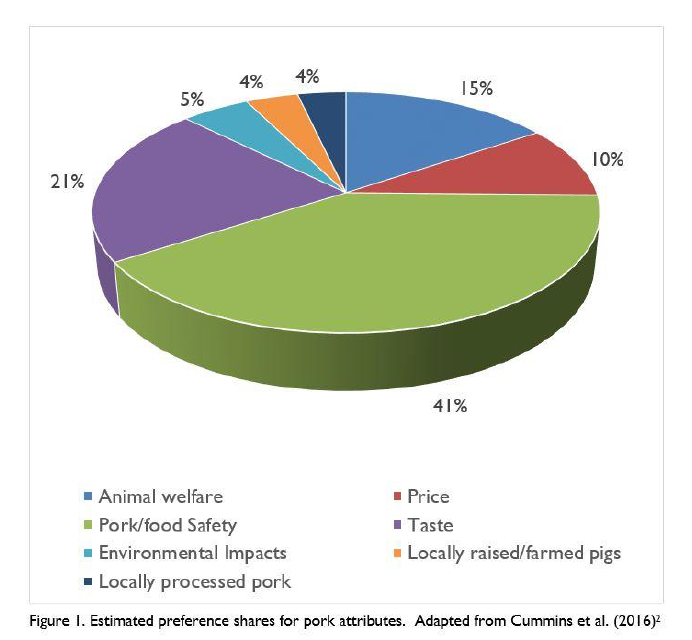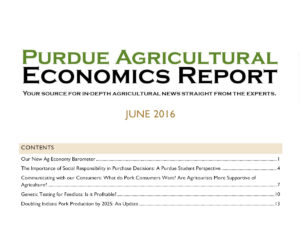Communicating with our Consumers: What Do Pork Consumers Want? Are Agritourists More Supportive of Agriculture?
June 12, 2016
PAER-2016-07
Unattributed
What do consumers want? Today they have quick and easy access to information from a wide breadth of sources across many subjects. This change occurred over the past two decades as technological innovations in communications exploded. The internet, smart phones and widespread use of computers revolutionized how and where people gained knowledge and shaped their opinions.
This change has boosted the power of the consumer voice in purchasing decisions as well as the flow of information around different products. In turn, agriculture’s need to understand consumers and their motivations when it comes to product selection has increased. Given their improved access to information, many factors come into play when consumers make decisions about what to buy. They want to know about the product and, when it comes to livestock, some want to know about the quality of life the animal had among other considerations.
Increased consumer interest in their food sources is a relatively new phenomenon, occurring roughly in tandem with the communications technology revolution. Both an increased interest in food, and increased access to information, has made communication with consumers an increasingly recognized priority across food and agricultural industries today.
One of the first steps toward efficient and productive communication is an understanding of the audience with whom you are communicating. This article provides reviews of two of our studies into consumers’ attitudes. In the first, we report on consumers attribute preferences for pork and in the second, we explore how consumer participation in agritourism affects their perceptions of the livestock industry
UNDERSTANDING CONSUMER PORK ATTRIBUTE PREFERENCES
Consumers make tradeoffs in attributes, consciously or subconsciously, when making decisions about what to buy . In the recently published study Understanding Consumer Pork Attribute Preference [3] , the researchers conducted a U.S. consumer survey of 1004 individuals targeted to be representative of age, gender, income and region. The objective of the analysis was to examine which pork attributes were influential to consumers in their purchase decisions.
Seven different pork attributes were studied, and in order of preference they were: pork/food safety, taste, animal welfare, price, environmental impact, locally raised/farmed pigs and locally processed pork. As can be seen in Figure 1, food safety was the most important attribute by a wide margin (41%), followed by taste (21%) and shortly after that by considerations of animal welfare (15%). Food safety and taste are unsurprising top selections, yet animal welfare comes in third with a solid margin lead over price (10%). 
In this light, animal welfare from a consumer perspective is an element that needs to be better understood. Some consumers see the production system in which the animal is raised and processed as an important attribute. What this same study revealed are certain demographics which were found to be determinants of the relative ranking of importance of pork attributes. For example, analysis revealed that men were less influence by animal welfare issues than were women. Those who had purchased pork in the past 12 months also placed less importance on animal welfare.
Individuals who owned a cat or a dog placed a higher value on animal welfare attributes. In addition, those who indicated they had a source of animal welfare information placed a higher value on animal welfare in their purchase decisions. These findings surrounding pet ownership and access to animal welfare information support previous studies that have found similar relationships. [4]
EXPLORING AGRITOURISM EXPERIENCES AND PERCEPTIONS OF PORK PRODUCTION
Communicating with interested consumers can take many shapes and forms. Livestock producers today are interacting in a variety of ways, such as how their products are displayed in stores, how they choose to market their product, their interaction with their communities and by inviting people onto their farms. Transparency is a critical component of trust-building, a necessary component for breaking down communication barriers and fostering informed decision making. [5]
Inviting people to visit farm operations, or agritourism, is a potential way to build transparency with the public. The purpose of agritourism is often to show people what happens on the farm so they can become better informed about farming practices and activities. The underlying assumption of this practice is often that as people learn about the farm, they will have less concern about the production process as a whole. This research sought to explore who visited livestock farms and especially to answer whether consumers who participate in agritourism actually have reduced concerns about agricultural industries.
This section captures the findings of a new study, Exploring Agritourism Experience and Perceptions of Pork Production [6] . This article looks at the characteristics of people who visit agricultural locations and their preferences. The authors conducted an online survey with 857 respondents representative of the U.S. population. Of those surveyed, 69% of the respondents had visited a livestock operation (dairy farm, pig farm and/or horse farm).
Key findings of this study revealed several items of note. First, being a tourist in one area was correlated with being a tourist at another farm attraction as well. Those who had participated in agritourism once were likely to have engaged in it a second or third time. Second, the results did not differ in terms of gender, age or region. However, they did differ in terms of income level. Those who reported a high income level were more likely to have visited a farm. It is likely that findings related to income level are generalizable beyond agritourism, to tourism and travel in general. Given that travel is costly in terms of money (and time), it is to be expected that those who travel more are likely those with higher income levels.
Results generally support the hypothesis that those who visit animal operations were more supportive of livestock industries. Importantly, the majority of people surveyed agreed that livestock agriculture was an important industry in their state. This was true of those who had not visited a farm, yet those who had visited a livestock operation agreed more strongly with that statement. In a similar result, both groups were generally supportive of livestock industry growth in their county, but those who had visited a livestock farm were significantly more supportive. When asked if they opposed new livestock buildings in their county, both groups generally disagreed with that statement, but those who had visited a livestock operation disagreed more strongly.
In turn, those who have visited a farm demonstrated a more critical eye towards agriculture in some cases. For instance, those who had visited livestock operations more frequently were more concerned with the impacts of local water quality issues from livestock operations. These results generally show that those who have visited livestock farms are more supportive and interested in livestock agriculture However, while agritourists tend to support the livestock industry and believe it is important they may still ask critical questions. In fact, those who visit through agritourism are likely to be better inform
SUMMARY
Lines of communication have become more open between food consumers and producers in the past two decades. Consumers today are more demanding about the way their food is produced, processed, packaged, and delivered.
This article reviewed two studies related to the livestock industries. The first was a survey that identified the attributes most important to U.S. pork consumers. The most important attribute was that the pork be safe to consume with an estimated preference share of 41%. This was followed by the attribute of taste 21%, animals treated in a humane manner 15%, and price 10%. That study also explored which consumers were more concerned about animal welfare issues and included women, pet owners, and those who had access to animal welfare information.
One way farmers have increased communications with consumers and informed them about agricultural production is through agritourism. The second study helped identify which consumers have visited a livestock farm through agritourism and whether those who had visited a livestock farm were supportive of the livestock industry. In general those who had visited a livestock farm were found to be more supportive of the livestock industry that those who had not visited a farm. However, there were also indications that those who had visited farms were more aware of the issues and problems in the livestock industry.
These studies underscores yet again the importance of strong communication starting from a place of active listening. Understanding who consumers are and what they value can go a long way to creating understanding and trust, and it gives producers greater insights into their customers and a greater ability to respond appropriately.
[3] Cummins, Ann M., Nicole J. Olynk Widmar, Candace C. Croney, and Joan R. Fulton. “Understanding Consumer Pork Attribute Preferences.” Theoretical Economics Letters TEL 06.02 (2016): 166-77. Web.
[4] For additional information, see McKendree, M.G.S., Croney, C.C. and Widmar, N.J.O. (2014) Effects of Demographic Factors and Information Sources on United States Consumer Perception of Animal Welfare. Journal of Animal Science, 92, 3161-3173. http: //dx. doi. org/10. 2527/jas. 2014-6874
[5] “2015 Consumer Trust Research: A Clear View of Transparency.” Center for Food Integrity (2015).
[6] Cummins, Ann M., Nicole J. Olynk Widmar, Candace C. Croney, and Joan R. Fulton. “Exploring Agritourism Experience and Perceptions of Pork Production.” Agricultural Sciences AS 07.04 (2016): 239-49. Web.
